Runze Yan
GPT-PPG: A GPT-based Foundation Model for Photoplethysmography Signals
Mar 11, 2025Abstract:This study introduces a novel application of a Generative Pre-trained Transformer (GPT) model tailored for photoplethysmography (PPG) signals, serving as a foundation model for various downstream tasks. Adapting the standard GPT architecture to suit the continuous characteristics of PPG signals, our approach demonstrates promising results. Our models are pre-trained on our extensive dataset that contains more than 200 million 30s PPG samples. We explored different supervised fine-tuning techniques to adapt our model to downstream tasks, resulting in performance comparable to or surpassing current state-of-the-art (SOTA) methods in tasks like atrial fibrillation detection. A standout feature of our GPT model is its inherent capability to perform generative tasks such as signal denoising effectively, without the need for further fine-tuning. This success is attributed to the generative nature of the GPT framework.
Explore the Use of Time Series Foundation Model for Car-Following Behavior Analysis
Jan 13, 2025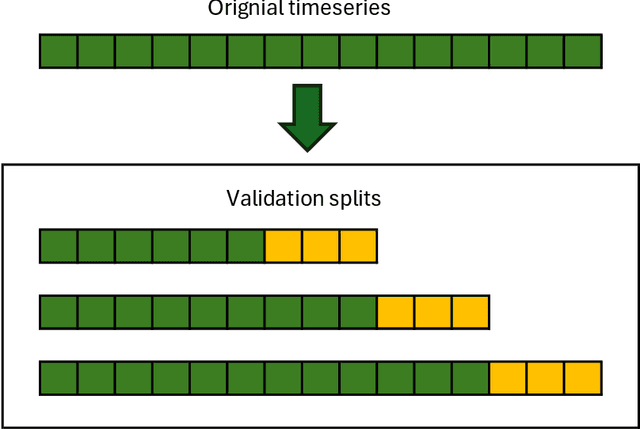



Abstract:Modeling car-following behavior is essential for traffic simulation, analyzing driving patterns, and understanding complex traffic flows with varying levels of autonomous vehicles. Traditional models like the Safe Distance Model and Intelligent Driver Model (IDM) require precise parameter calibration and often lack generality due to simplified assumptions about driver behavior. While machine learning and deep learning methods capture complex patterns, they require large labeled datasets. Foundation models provide a more efficient alternative. Pre-trained on vast, diverse time series datasets, they can be applied directly to various tasks without the need for extensive re-training. These models generalize well across domains, and with minimal fine-tuning, they can be adapted to specific tasks like car-following behavior prediction. In this paper, we apply Chronos, a state-of-the-art public time series foundation model, to analyze car-following behavior using the Open ACC dataset. Without fine-tuning, Chronos outperforms traditional models like IDM and Exponential smoothing with trend and seasonality (ETS), and achieves similar results to deep learning models such as DeepAR and TFT, with an RMSE of 0.60. After fine-tuning, Chronos reduces the error to an RMSE of 0.53, representing a 33.75% improvement over IDM and a 12-37% reduction compared to machine learning models like ETS and deep learning models including DeepAR, WaveNet, and TFT. This demonstrates the potential of foundation models to significantly advance transportation research, offering a scalable, adaptable, and highly accurate approach to predicting and simulating car-following behaviors.
Measuring Spiritual Values and Bias of Large Language Models
Oct 15, 2024



Abstract:Large language models (LLMs) have become integral tool for users from various backgrounds. LLMs, trained on vast corpora, reflect the linguistic and cultural nuances embedded in their pre-training data. However, the values and perspectives inherent in this data can influence the behavior of LLMs, leading to potential biases. As a result, the use of LLMs in contexts involving spiritual or moral values necessitates careful consideration of these underlying biases. Our work starts with verification of our hypothesis by testing the spiritual values of popular LLMs. Experimental results show that LLMs' spiritual values are quite diverse, as opposed to the stereotype of atheists or secularists. We then investigate how different spiritual values affect LLMs in social-fairness scenarios e.g., hate speech identification). Our findings reveal that different spiritual values indeed lead to different sensitivity to different hate target groups. Furthermore, we propose to continue pre-training LLMs on spiritual texts, and empirical results demonstrate the effectiveness of this approach in mitigating spiritual bias.
SQUWA: Signal Quality Aware DNN Architecture for Enhanced Accuracy in Atrial Fibrillation Detection from Noisy PPG Signals
Apr 15, 2024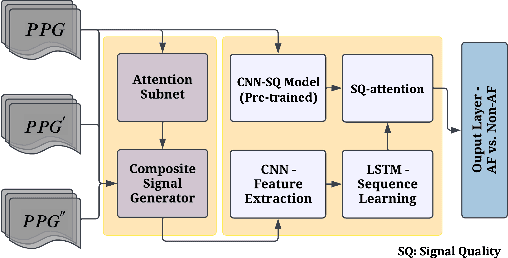

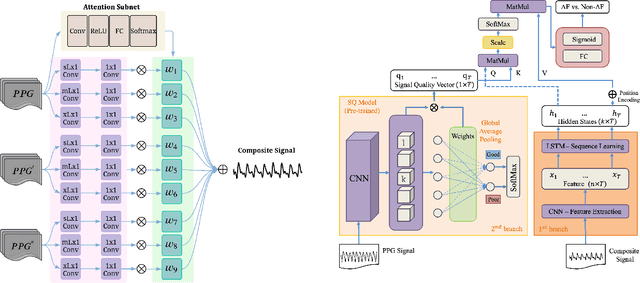

Abstract:Atrial fibrillation (AF), a common cardiac arrhythmia, significantly increases the risk of stroke, heart disease, and mortality. Photoplethysmography (PPG) offers a promising solution for continuous AF monitoring, due to its cost efficiency and integration into wearable devices. Nonetheless, PPG signals are susceptible to corruption from motion artifacts and other factors often encountered in ambulatory settings. Conventional approaches typically discard corrupted segments or attempt to reconstruct original signals, allowing for the use of standard machine learning techniques. However, this reduces dataset size and introduces biases, compromising prediction accuracy and the effectiveness of continuous monitoring. We propose a novel deep learning model, Signal Quality Weighted Fusion of Attentional Convolution and Recurrent Neural Network (SQUWA), designed to learn how to retain accurate predictions from partially corrupted PPG. Specifically, SQUWA innovatively integrates an attention mechanism that directly considers signal quality during the learning process, dynamically adjusting the weights of time series segments based on their quality. This approach enhances the influence of higher-quality segments while reducing that of lower-quality ones, effectively utilizing partially corrupted segments. This approach represents a departure from the conventional methods that exclude such segments, enabling the utilization of a broader range of data, which has great implications for less disruption when monitoring of AF risks and more accurate estimation of AF burdens. Our extensive experiments show that SQUWA outperform existing PPG-based models, achieving the highest AUCPR of 0.89 with label noise mitigation. This also exceeds the 0.86 AUCPR of models trained with using both electrocardiogram (ECG) and PPG data.
Detection of Racial Bias from Physiological Responses
Feb 02, 2021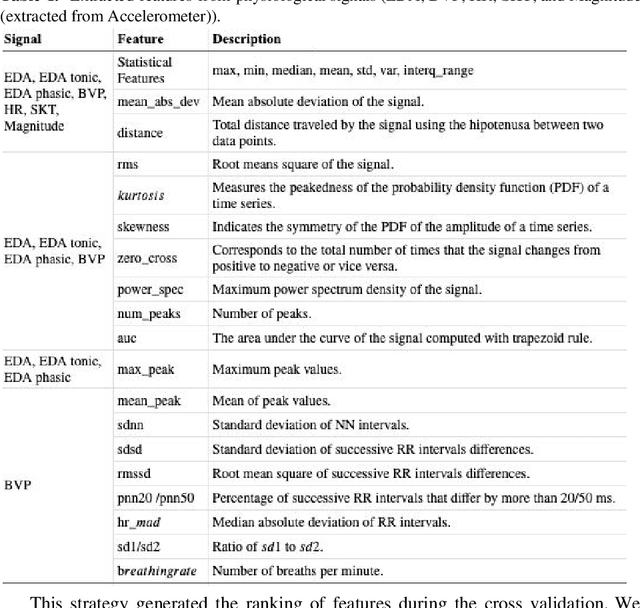
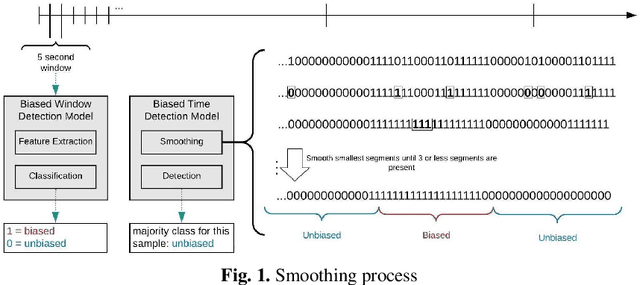
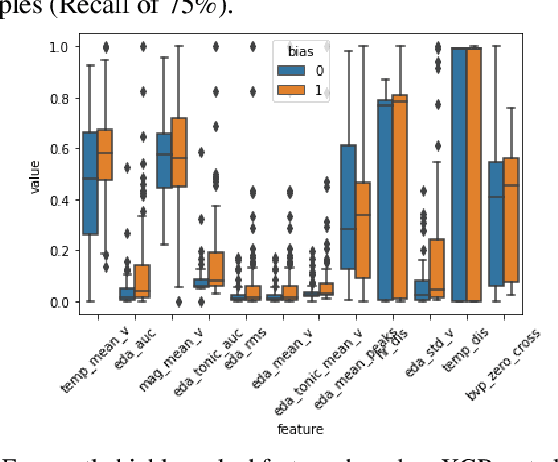
Abstract:Despite the evolution of norms and regulations to mitigate the harm from biases, harmful discrimination linked to an individual's unconscious biases persists. Our goal is to better understand and detect the physiological and behavioral indicators of implicit biases. This paper investigates whether we can reliably detect racial bias from physiological responses, including heart rate, conductive skin response, skin temperature, and micro-body movements. We analyzed data from 46 subjects whose physiological data was collected with Empatica E4 wristband while taking an Implicit Association Test (IAT). Our machine learning and statistical analysis show that implicit bias can be predicted from physiological signals with 76.1% accuracy. Our results also show that the EDA signal associated with skin response has the strongest correlation with racial bias and that there are significant differences between the values of EDA features for biased and unbiased participants.
 Add to Chrome
Add to Chrome Add to Firefox
Add to Firefox Add to Edge
Add to Edge